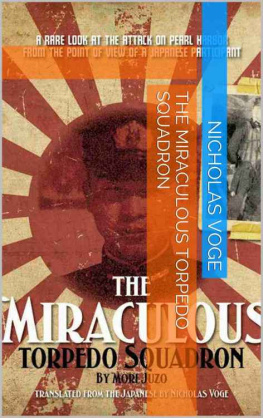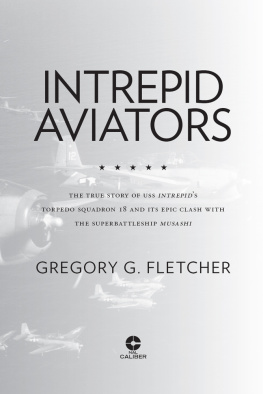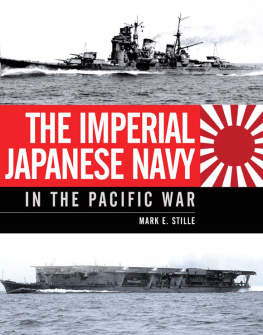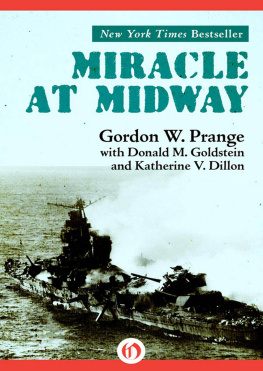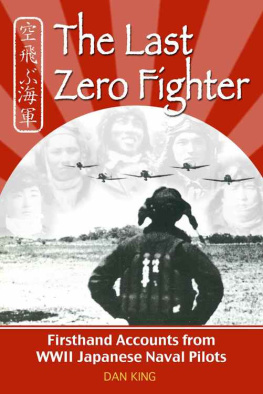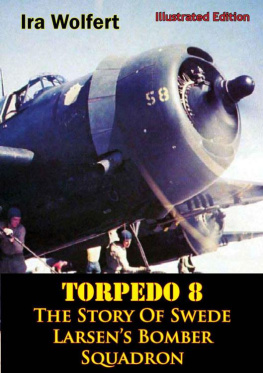
Cart Driver
Foreword by Sabur Sakai
Near the north exit of Nishiogikubo Station, among the many bars, noodle shops and other colorful establishments catering to the late-night crowd, is a small, tastefully furnished bar with the unusual name of Cart Driver. At the entrance, right next to the sign, is a horseshoe nailed firmly to the wall. The bars owner is one of the Imperial Japanese Navys elite torpedo bomber pilots. In addition to flying in China, the Indian Ocean and the Pacific, during the attack on Pearl Harbor he put a torpedo into the battleship California. Unlike so many of his fellow pilots, good fortune saw him survive the war. His name is Jz Mori.
Mori and I were classmates at the Navys flight training center at Kasumigaura. I went into fighters and Mori to torpedo bombers. What astonished me was that when the time came to choose the planes we wanted to fly, almost everyone chose the more glamorous fighters or dive bombers but not Mori. For his first, second and third choices he chose torpedo bombers for each. He knew exactly what he wanted to do. Our superiors must have sensed this also, for he was in fact chosen to become a torpedo bomber pilot. More than a few of us thought he was a pretty strange character. However, looking back, I can see that this was what Mori was born for. From a young age he devoted his entire life to flying, and even today he takes great pride in having flown torpedo bombers. And that is why, even after the war, he named the small bar he owns and operates Cart Driver . (1)
But what on earth does the name Cart Driver have to do with being a pilot?
When we went out on the town in the evening the first thing we did was get something to drink. As sometimes happens during such
excursions, the combination of alcohol, testosterone and youthful exuberance led to heated discussions with other groups of pilots. At these times the torpedo bomber pilots would say we were nothing but show offs and stunt pilots.
Show offs? We would yell, You guys are just a bunch of cart drivers hauling around bombs and torpedoes. The moniker stuck, and it wasnt long before all torpedo pilots were called cart drivers.
That Mori continued to use this name after the war as the name of his bar was just the sort of thing he would do. It was a reflection of the commitment and determination he showed in whatever he did.
There were twenty-five of us trainees all together. All of us went off to fight deadly battles in the Pacific, only a few returned. Although Mori and I were both wounded in air battles over Guadalcanal he losing his right hand and me losing my left eye neither of us gave up and we both served again until the end of the war. That we both ended up living in Tky after the war was another bond that has made us such close friends.
Mori and I were born and came of age in a very harsh time for our country, and we were subjected to the education and navy pilot training of that era. This is something we are both very proud of. We risked our lives to protect Japan. Whether we won the war or lost is another matter entirely.
Of course, Japan should never start another war. Our state of mind and way of thinking when we were young would be incomprehensible to the young people of today. However, the ferocious war that took place more than twenty years ago is an undeniable fact, and it is important that people face that fact.
Moris autobiography is unlike the books written by us fighter pilots and has a special impact all its own. His plane fired the first shots at Pearl Harbor and he completed more than a hundred torpedo and bombing missions. Today youll find him behind the small bar whose dimly lit interior resembles a ships ready room. Hell be wearing a white glove on his prosthetic right hand, mixing drinks, and in the background will be playing a tape of old war songs. Neither in his face nor in his posture will you notice any self-pity of a wounded warrior. He stands straight, always wears a smile and is ever ready with a joke.
But dont be deceived. From time to time a special fire burns in his eyes that reminds you that this is a man who has stared down the anti-aircraft fire of enemy ships as he bored in unwaveringly in an attack.
After reading this book why dont you drop by Cart Driver for a drink. If youre lucky you may hear an interesting story or two that werent in the book about what it was like to fly torpedo planes in the Pacific War.
December, 1972 The Anniversary of the Pearl Harbor attack

Flying the legendary Zero fighter Sabur Sakai became one of Japans most famous air aces. In this early photo taken in China hes sitting in the cockpit of an A5M Claude. Wikipedia
The Magnificent Torpedo Squadron
The Life of a Japanese WWII Torpedo Plane Pilot
By Jz Mori
For all my comrades who flew with the clouds to southern skie s and neve r returned.
Chapter I
Towards The Limitless Sky
On December 23, 1942, exactly one year and fourteen days after the start of the Pacific War, I was lying in a hospital bed in the reconstructive surgery department of the Yokosuka naval hospital recalling the many battles Id participated in.
As a torpedo bomber pilot on the carrier Sry Id taken part in the Pearl Harbor attack that started the war with America. I then flew in the Wake Island and the Indian Ocean operations. After taking part in the Battle of Midway on June 5 and 6, 1942, I was reassigned to the carrier Juny and fought in the Solomon Islands. It was during an air battle over Guadalcanal on October 17 that my right hand was shot off. I ditched in the sea off Guadalcanal and had to have my hand amputated.
My emotions at the time, a mixture of disappointment and regret, are very hard to describe. Although I had narrowly escaped death and returned alive I felt neither joy nor happiness at having survived. If anything I felt a deep sense of isolation and loneliness for being safely in a hospital bed in Japan while my fellow pilots were still facing death as if I had somehow abandoned them in their time of need.
Lying quietly on my back, the ceiling soon became a kaleidoscope of images as the memories came flooding back. I saw all those pilots who, their planes on fire, intentionally crash-dived into enemy positions. These recollections made me feel that I could never fly again, that I was done with flying forever. But those images were also interspersed with all the happy memories and unforgettable sensations of my first flights.
Soon the ceiling and walls of my room dissolved in a flood of tears and before I knew it I had returned to my distant past.
****
I was born on February 9, 1917 in the small town of za Akazawa in Saitama Prefecture. I was the third son of seven children by Shunz Mori. However, because one of my older brothers and my older sister died in infancy we always thought of ourselves as a family with five children.
I had just entered primary school when the depression hit Japan and farming villages like ours fell deeply into poverty. Our family was especially hard hit. The small forest and fields we owned were soon gone. As if that werent bad enough, my father had guaranteed a loan for someone who went broke, and as a result we lost the two small properties we owned. The seven of us were soon desperately poor with no hope in sight.
Our village specialized in raising silkworms and cutting timber but the scale of our operations was small. In our fields we grew buckwheat, potatoes and vegetables. We had almost no rice paddies so we only ate rice a couple of times a year. Today it is almost impossible to imagine a life of such poverty. When I was in primary school I was always getting into mischief and often found myself standing at the teachers desk for punishment.
Next page
